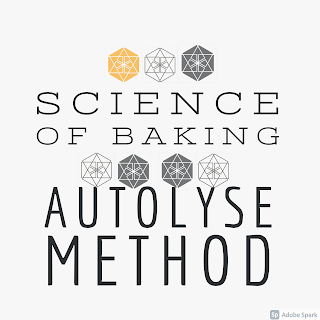Science of Autolyse Method
Autolyse
An Autolyse is a gentle mixing of flour and water in a bread recipe followed by a 20-60 minutes resting period. After the rest the remaining Ingredients are added and kneadeding begins. This simple pause allows for some rather magical changes to occur in your bread dough. When doing autolyze you just need to mix well water and starch until fully hydrated rest for an hour in covered mixing bowl, in that way it stimulates the protein in the flour that form a gluten in the mixture and breakdown sugar content in the flour that will help the yeast in during proofing method. In that way also it will lessen the kneading process of dough. Over mixed or over kneaded dough results in less flavor and color and texture of bread. It is best for artisans and croissant bread.
History
French Scientist and bread expert Prof. Raymond Calvel develop this technique in 1974. In response to what he saw in a deterioration in French Bread production. In the 90s and 60s two speed electric mixer came into use in France and bakers adopted more aggressive mixing practices. According to Calvel, this result in a very white and high volume bread. which to his dismay bean popular in France. The intensive mixing caused the dough to mature quickly, which meant less fermentation required result with bread in less flavor.
Science of Autolyse
In Autolyse, Two Enzymes are present in Flour. Protease and Amylasen begin their work during the process.
Protease Enzymes degrade the protein in flour, which encourages extensibility.
Amylase Enzymes turn the flour starch into sugar that yeast can consume
Proper dough development requires a balance of both extensibility and elasticity. By delaying the addition of yeast, sourdough starter and salt (all of which can have effect on gluten), the extensibility of dough has a better chance to develop. Once Kneading Begins, the dough develops elasticity. Which is the quality that allows the dough to retain its shape. When Flour is mixed with water several biochemical process start to occur. Those event takes place more efficient when an autolyse period is included, simple because water gets extra time to penetrate and fully hydrate the flour particles. At that point the water came into contact and coats starch and protein flour, endogenous digestive enzymes that exist in grain kernel and hence on the flour started to breakdown starch and protein molecules, before yeast is added. The result, simple sugar is released and additionally a premature gluten matrix is formed. Some simple sugar, like disaccharide maltose are excellent sources for yeast cell as to start readily the fermentation process. On the other hand, small scale digestion of gluten proteins gives irse to new "gluten seeds" for building up a network that is extensible enough.
As a general rule, the longer the autolyse time
- Shorter mixing time
- Shorter dough stability duration
- Less tolerance of over mixing
- More extensible and less elastic
- Better for sheeting process for croissants
- Easier and faster for dough to expands during baking
- Better aroma and flavor
Can you add salt in autolyse
salt improves the flavor the bread and has essentials benefits of the dough fermentation. During fermentation, it also creates elasticity in your dough. Autolysing without salt is the common way to autolyse by bakers. By removing salt for autolyse the complex gluten starch to forms but become less elastic. The extensible process of gluten are improved so dough made in this format is able to stretch more. Autolyse without salt has proven better oven spring.
Can you add yeast in Autolyse
It is possible to add yeast in autolyse but generally not the best idea. Adding yeast to dough will start fermenting the protein and starch start to create gas the second phase of fermentation, The purpose of autolyse is to allow the flour to soften and develop structure. By adding an active levain you will not be autolysing, you are making just a dough.



Comments
Post a Comment